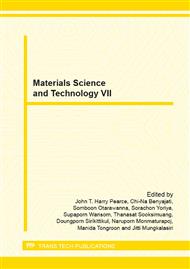[1]
World Health Organization, "Guidelines for drinking-water quality - 4th ed." WHO Library Cataloguing-in-Publication Data, 2011.
Google Scholar
[2]
A. Elham, T. Hossein, and H. Mahnoosh, Removal of Zn(II) and Pb (II) ions using rice husk in food industrial wastewater, J. Appl. Sci. Environ. 14(2011) 159 - 162.
DOI: 10.4314/jasem.v14i4.63306
Google Scholar
[3]
A. K. Meena, K. Kadirvelu, G. K. Mishraa, C. Rajagopal, and P. N. Nagar, Adsorption of Pb(II) and Cd(II) metal ions from aqueous solutions by mustard husk, J. Hazard. Mater. 150(2008) 619–625.
DOI: 10.1016/j.jhazmat.2007.05.011
Google Scholar
[4]
I. U. Iba, M. O. Wegwu, and J. O. Akaninwor, Removal of iron, zinc and magnesium from polluted water samples using thioglycolic modified oil-palm fibre, African J. Biochem Res. 1(2007) 11–13.
Google Scholar
[5]
E. Khongkasem, N. Khlongkarnpanich, W. Weangkaew, and K. Wantala, Effect on adsorption of Cd(II) ions by modified coir pith as agricultural waste. J. Met. Mat. Min. 20(2010) 73–76.
Google Scholar
[6]
K. Kadirvelu, K. Thamaraiselvi, and C. Namasivayam, Removal of heavy metals from industrial wastewaters by adsorption onto activated carbon prepared from an agricultural solid waste, Bioresource Technol. 76(2001) 63–65.
DOI: 10.1016/s0960-8524(00)00072-9
Google Scholar
[7]
K. Kadirvelu, and C. Namasivayam, Activated carbon from coconut coirpith as metal adsorbent: Adsorption of Cd(II) from aqueous solution, Adv Environ Res. 7(2003) 471–478.
DOI: 10.1016/s1093-0191(02)00018-7
Google Scholar
[8]
K. Wantala, S. Sthiannopkao, B. Srinameb, N. Grisdanurak, K.-W. Kim, and S. Han, Arsenic Adsorption by Fe Loaded on RH-MCM-41 Synthesized from Rice Husk Silica, J. Environ. Eng. 138(2011) 119–128.
DOI: 10.1061/(asce)ee.1943-7870.0000455
Google Scholar
[9]
C. Namasivayam, and K. Kadirvelu, Activated carbons prepared from coir pith by physical and chemical activation methods, Bioresource Technol. 62(1997) 123–127.
DOI: 10.1016/s0960-8524(97)00074-6
Google Scholar
[10]
C. R. Teixeira Tarley and M. A. Zezzi Arruda, Biosorption of heavy metals using rice milling by-products. Characterisation and application for removal of metals from aqueous effluents, Chemosphere. 54(2004) 987–995.
DOI: 10.1016/j.chemosphere.2003.09.001
Google Scholar
[11]
M. Malandrino, O. Abollino, A. Giacomino, M. Aceto, and E. Mentasti, "Adsorption of heavy metals on vermiculite: Influence of pH and organic ligands," Journal of Colloid and Interface Science, 299(2006) 537–546.
DOI: 10.1016/j.jcis.2006.03.011
Google Scholar
[12]
A. B. Pérez-Marín, V. M. Zapata, J. F. Ortuño, M. Aguilar, J. Sáez, and M. Lloréns, Removal of cadmium from aqueous solutions by adsorption onto orange waste, J. Hazard. Mater. 139(2007) 122–131.
DOI: 10.1016/j.jhazmat.2006.06.008
Google Scholar
[13]
M. Mohammad, S. Maitra, N. Ahmad, A. Bustam, T. K. Sen, and B. K. Dutta, Metal ion removal from aqueous solution using physic seed hull, J. Hazard. Mater.179(2010) 363–372.
DOI: 10.1016/j.jhazmat.2010.03.014
Google Scholar
[14]
K. K. Krishnani, X. Meng, C. Christodoulatos, and V. M. Boddu, Biosorption mechanism of nine different heavy metals onto biomatrix from rice husk, J. Hazard. Mater. 153(2008) 1222–1234.
DOI: 10.1016/j.jhazmat.2007.09.113
Google Scholar
[15]
B. C. Qi, C. Aldrich, Biosorption of heavy metals from aqueous solutions with tobacco dust, Bioresource Technol. 99(2008) 5595–5601.
DOI: 10.1016/j.biortech.2007.10.042
Google Scholar
[16]
M. M. Rao, D. K. Ramana, K. Seshaiah, M. C. Wang, and S. W. C. Chien, Removal of some metal ions by activated carbon prepared from Phaseolus aureus hulls, J. Hazard. Mater. 166(2009) 1006–1013.
DOI: 10.1016/j.jhazmat.2008.12.002
Google Scholar


